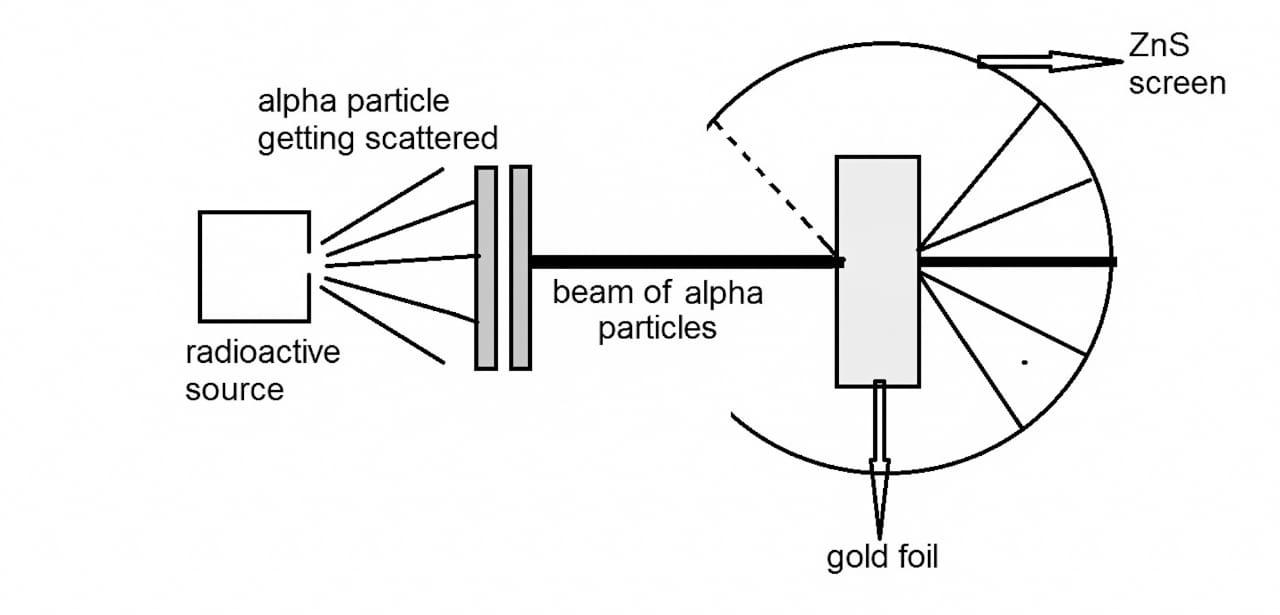
Explain Rutherford’s
Answer
497.4k+ views
Hint: Rutherford’s experiment was regarding the proposal of the structure of atoms. He used a metal sheet in his experiment which was bombarded with particles. These particles are a form of radiation.
Complete step by step answer:
Diagram of Rutherford’s

Rutherford used the observations of Thomson’s experiment to propose the atomic structure. Rutherford conducted the experiment using radioactivity phenomenon. He used radium bromide,
Rutherford made some observations in this experiment and gave the conclusions accordingly which are as follows:
1) Most of the
2) He then observed that some of the
3) He also observed that very few
4) He also concluded that along with the positively charged particles most of the mass is concentrated in a very small volume. He called this region a nucleus.
5) He proposed that electrons are present in particular orbits around the nucleus of the atom. These electrons which are negatively charged species revolve around the nucleus.
5) Both the electrons which are negatively charged particles and the nucleus which is positively charged are held by electrostatic force of attraction.
Additional Information:
The size of the nucleus was found to be less than
Note: Rutherford gave the basic structure of an atom which was further referred for experiments. He could not explain about the arrangement of the electrons in the orbits. Also, Rutherford could not explain the stability of the atom.
Complete step by step answer:
Diagram of Rutherford’s

Rutherford used the observations of Thomson’s experiment to propose the atomic structure. Rutherford conducted the experiment using radioactivity phenomenon. He used radium bromide,
Rutherford made some observations in this experiment and gave the conclusions accordingly which are as follows:
1) Most of the
2) He then observed that some of the
3) He also observed that very few
4) He also concluded that along with the positively charged particles most of the mass is concentrated in a very small volume. He called this region a nucleus.
5) He proposed that electrons are present in particular orbits around the nucleus of the atom. These electrons which are negatively charged species revolve around the nucleus.
5) Both the electrons which are negatively charged particles and the nucleus which is positively charged are held by electrostatic force of attraction.
Additional Information:
The size of the nucleus was found to be less than
Note: Rutherford gave the basic structure of an atom which was further referred for experiments. He could not explain about the arrangement of the electrons in the orbits. Also, Rutherford could not explain the stability of the atom.
Recently Updated Pages
Master Class 11 Economics: Engaging Questions & Answers for Success

Master Class 11 Business Studies: Engaging Questions & Answers for Success

Master Class 11 Accountancy: Engaging Questions & Answers for Success

Master Class 11 English: Engaging Questions & Answers for Success

Master Class 11 Computer Science: Engaging Questions & Answers for Success

Master Class 11 Maths: Engaging Questions & Answers for Success

Trending doubts
State and prove Bernoullis theorem class 11 physics CBSE

1 ton equals to A 100 kg B 1000 kg C 10 kg D 10000 class 11 physics CBSE

State the laws of reflection of light

One Metric ton is equal to kg A 10000 B 1000 C 100 class 11 physics CBSE

Difference Between Prokaryotic Cells and Eukaryotic Cells

1 Quintal is equal to a 110 kg b 10 kg c 100kg d 1000 class 11 physics CBSE




